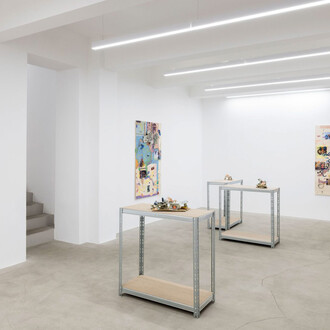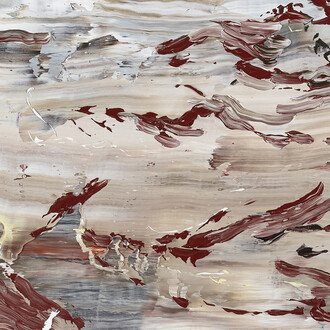Galleria Vik Milano is pleased to present Travelogues. Diari di viaggio, a group exhibition bringing together a generation of Italian artists who came of age between the 1990s and the early 2000s, a period marked by a renewed interest in painting as a critical language and a way of engaging with reality.
In those years, at the height of the postmodern season, figurative painting regained a central place in the artistic debate, reinterpreting in a contemporary key — as happened in other fields such as cinema and literature — the great classical genres of tradition: portrait, still life, and landscape. New momentum came through collective experiences like the Officina milanese, a movement that gathered some of the most attentive painters of the time around a shared reflection on landscape as a form of visual and symbolic identity.
Travelogues belongs to this line of research, with curator Alessandro Riva as one of its main critical voices. His commitment to this area is evidenced by numerous exhibitions from those years exploring the relationship between traditional genres and contemporary experimentation — notably Sui generis – Redefining genre in new italian art, held at the PAC in Milan in 2000, which focused on the transformation and overcoming of classical genres in contemporary painting.
Twenty years later, this new exhibition offers an updated reflection on the theme of travel and the role of landscape — real, mental, and symbolic — in the work of twelve Italian artists, at a time when the very idea of landscape seems to have dissolved.
In recent decades, landscape — understood as a physical and cultural space imbued with form, memory, and identity — has undergone a profound transformation, almost to the point of vanishing. Widespread urbanization, the blurring of boundaries between city and countryside, and the proliferation of anonymous, utilitarian structures have created a hybrid, indistinct territory. Alongside this concrete change has come a perceptual dematerialization: landscape is no longer experienced as a direct and continuous encounter, but as a fragmented stream of images, filtered through screens and digital devices.
In this scenario, painting assumes a role of resistance and symbolic reconstruction. The artists on display reimagine landscape not as a mere representation of reality, but as a mental, emotional, and cultural space — an interior diary to be rebuilt through memory, imagination, and observation.
From Marco Petrus’ geometric, stylized Milan to the timeless, suspended mountains of Velasco Vitali and Alessandro Busci; from the “supernature” of Massimiliano Alioto, where natural and artificial elements merge in an organic and disquieting vision, to the great cities reinterpreted with the measured, luminous gaze of Aldo Damioli’s neo-vedutism; from the rarefied, almost informal countryside and seascapes of Giovanni Frangi and Alessandro Papetti, to Enrico Lombardi’s metaphysical, primal landscapes; from Luca Pignatelli’s views suspended between modernity and archaism, to Bernardo Siciliano’s vertiginous New York, and Andrea Zucchi’s intimate, exotic inner journeys — for all of them, landscape becomes a complex place of observation and projection, geography and memory, reality and constructed vision.
The exhibition’s only sculptor, Paolo Cassarà, turns his gaze not to the external landscape, but to one interiorized in the bodies and gazes of his contemporary female travelers: restless, hurried, and slightly neurotic figures moving through both physical and mental spaces with the same frenzied tension that defines our times.
Travelogues. Diari di viaggio thus offers an itinerary of visions, memories, and layered narratives, where travel is not merely physical displacement but a true exercise of vision. It is a tribute to painting as an act of resistance, and to its enduring capacity to evoke a possible geography of meaning.















